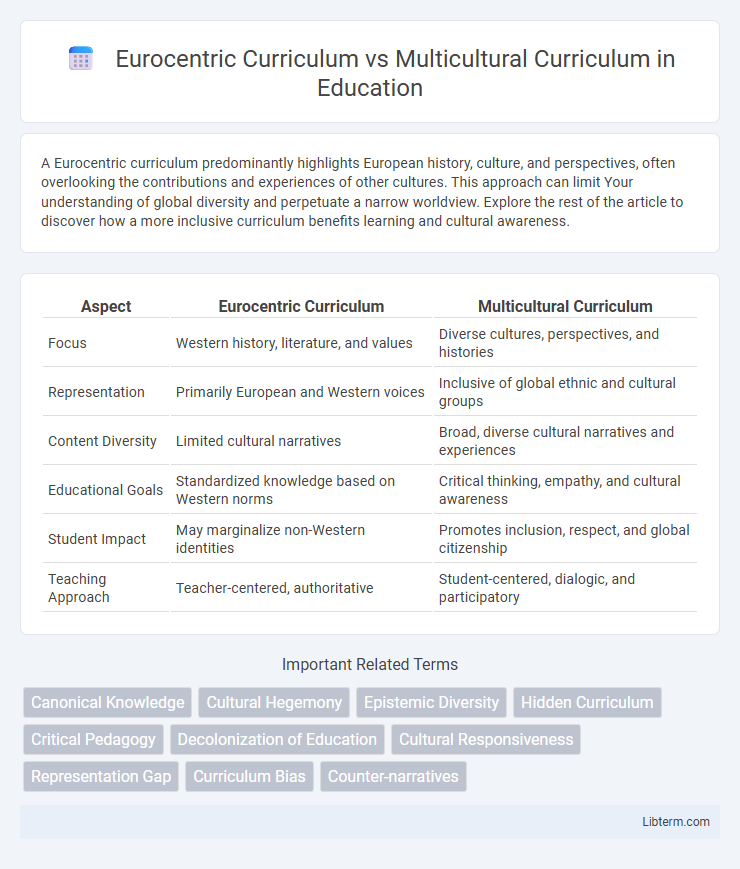A Eurocentric curriculum predominantly highlights European history, culture, and perspectives, often overlooking the contributions and experiences of other cultures. This approach can limit Your understanding of global diversity and perpetuate a narrow worldview. Explore the rest of the article to discover how a more inclusive curriculum benefits learning and cultural awareness.
Table of Comparison
| Aspect | Eurocentric Curriculum | Multicultural Curriculum |
|---|---|---|
| Focus | Western history, literature, and values | Diverse cultures, perspectives, and histories |
| Representation | Primarily European and Western voices | Inclusive of global ethnic and cultural groups |
| Content Diversity | Limited cultural narratives | Broad, diverse cultural narratives and experiences |
| Educational Goals | Standardized knowledge based on Western norms | Critical thinking, empathy, and cultural awareness |
| Student Impact | May marginalize non-Western identities | Promotes inclusion, respect, and global citizenship |
| Teaching Approach | Teacher-centered, authoritative | Student-centered, dialogic, and participatory |
Defining Eurocentric and Multicultural Curricula
Eurocentric curriculum centers on European history, literature, and values, often prioritizing Western perspectives and marginalizing non-European contributions. Multicultural curriculum incorporates diverse cultural viewpoints, histories, and knowledge systems, promoting inclusivity and representation of various ethnic, racial, and cultural groups. This approach enhances cultural awareness and prepares students to navigate a globalized society by embracing multiple narratives and identities.
Historical Origins of Eurocentric Education
Eurocentric education traces its origins to Western Europe, particularly during the Renaissance and Enlightenment periods when European knowledge, culture, and history were established as dominant global narratives. This curriculum often centers on European achievements, philosophies, and historical events, marginalizing contributions from non-European societies. In contrast, multicultural curricula aim to incorporate diverse historical perspectives, promoting inclusivity and acknowledging the interconnectedness of global cultures.
Cultural Representation in Curriculum Content
A Eurocentric curriculum primarily emphasizes Western history, literature, and perspectives, often marginalizing diverse cultural narratives. In contrast, a multicultural curriculum integrates multiple cultural viewpoints, representing varied ethnicities, languages, and traditions to promote inclusivity and cultural awareness. Effective cultural representation in curriculum content fosters critical thinking and empathy by validating students' diverse identities and global experiences.
Impacts on Student Identity and Belonging
Eurocentric curriculum often centers Western perspectives, which can marginalize students from diverse backgrounds and hinder their sense of identity and belonging. Multicultural curriculum incorporates diverse cultural narratives, fostering inclusivity and empowering students by validating their heritage and experiences. This inclusive approach enhances student engagement, self-esteem, and promotes a positive school climate that respects and celebrates diversity.
Academic Achievement and Equity Gaps
Eurocentric curriculum often centers on Western perspectives, which can limit academic achievement for students from diverse backgrounds by marginalizing their histories and experiences. Multicultural curriculum promotes inclusivity by integrating multiple cultural viewpoints, contributing to reduced equity gaps and enhanced engagement among minority students. Research shows that schools adopting multicultural curricula experience higher academic performance and greater cultural competence, supporting equitable educational outcomes.
Teacher Perspectives and Classroom Practices
Teachers adopting a Eurocentric curriculum often emphasize Western historical narratives and cultural values, shaping classroom practices that prioritize dominant cultural perspectives. In contrast, educators supporting a multicultural curriculum integrate diverse cultural content and foster inclusive pedagogies, encouraging critical thinking and representation of marginalized voices. These differing teacher perspectives influence lesson planning, resource selection, and student engagement strategies, ultimately impacting the inclusivity and relevance of classroom learning experiences.
Integration of Diverse Voices and Texts
A multicultural curriculum integrates diverse voices and texts by including narratives from various cultural, ethnic, and social backgrounds, promoting a more inclusive understanding of history, literature, and social studies. In contrast, a Eurocentric curriculum primarily centers on Western perspectives, often marginalizing or excluding non-European contributions and viewpoints. This inclusive approach fosters critical thinking, empathy, and cultural awareness, enhancing students' ability to navigate a globalized world.
Policy Trends in Curriculum Reform
Policy trends in curriculum reform increasingly prioritize shifting from a Eurocentric curriculum, which centers predominantly on Western perspectives and histories, to a multicultural curriculum that embraces diverse cultural narratives and global viewpoints. Governments and educational bodies are implementing frameworks that mandate inclusivity, cultural representation, and critical examination of historical biases to foster equity and social justice in education. Recent reforms emphasize curriculum content diversification, teacher training in cultural competence, and the integration of Indigenous and minority knowledge systems to promote cross-cultural understanding.
Challenges in Implementing Multicultural Approaches
Implementing multicultural curricula faces challenges such as resistance from educators accustomed to Eurocentric perspectives, limited resources for inclusive materials, and difficulties in adequately representing diverse cultures without stereotyping. Teacher training often lacks sufficient emphasis on cultural competence, hindering effective delivery of multicultural content. Institutional policies and standardized testing systems also frequently prioritize dominant cultural narratives, limiting the scope for genuinely diverse educational frameworks.
Future Directions for Inclusive Education
Future directions for inclusive education emphasize integrating multicultural curricula that reflect diverse cultures, histories, and perspectives to foster global awareness and equity among students. Shifting from a predominantly Eurocentric curriculum to one that values multiple cultural narratives supports critical thinking, cultural competence, and social justice. Educational policies and teacher training programs increasingly prioritize inclusivity and representation to prepare learners for diverse, interconnected societies.
Eurocentric Curriculum Infographic

 libterm.com
libterm.com